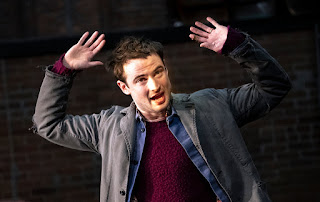Theater Review: Two monologues on death at the Public Theater
Sea Wall
Written by Simon Stephens
A Life
Written by Nick Payne
Directed by Carrie Cracknell
Starring Tom Sturridge and Jake Gyllenhaal
New York Public Theater
March 21, 2019
These two one actor/one act plays were ingeniously paired by
the New York Public Theater, and featured prime acting talent. In Sea Wall (2008) English playwright Simon
Stephens (b. 1971) tackles how a pretty normal guy processes the random death
of his young daughter. The text leaps between past, present, and future, only
revealing the actuality and circumstances of the death near the end of the 45
minutes. Stephens writes in a naturalistic style, relying on his actor, here
the outstanding English actor Tom Sturridge, to supply the overtones, repressed
pain and grief, and controlled emotion typical of how many men grieve. Sturridge’s
great performance carefully tread the line between over-emotiveness and dysfunctional
rationality. He adeptly portrayed a rational guy repressing and being
overwhelmed by a great tragedy, and never resorted to stock theater gestures or
melodrama in doing so. While very simple on the surface, using common language,
the script addressed religion, science, and humanism/love as responses to grief
without ever really committing to one as “the solution”. The result was a
marvelously subtle treatment of a most difficult topic.
The second play A Life
(2019) featured another British playwright (Nick Payne, b. 1984), this time starring
our millennial version of the “normal guy” Jimmy Stewart, the versatile Jake
Gyllenhaal (Donnie Darko, Brokeback
Mountain). This play alternated reflections by an average guy on the death
of a beloved father with the narrative of the birth of his first child. The
writing was more overtly virtuosic than Sea
Wall, veering rapidly between the two life events, often switching in mid-sentence
like James Joyce would do it, pivoting the narratives on a phrase like “fifteen
minutes” or “pale skin”. While both the play and the performance were more
technically demanding than Sea Wall,
I was less moved by them. The play did not achieve the naturalness and
connection of the first play, so I admired it more as a virtuosic writing
exercise, and was left without much of a take away message. But it was a
pleasure to see a talented actor like Gyllenhaal pull it off.
Both plays were set on dark, spot lit stages with minimal props,
and both had postmodern touches of breaking the fourth wall, as in when
Sturridge set up his own props before Sea
Wall or when Gyllenhall left the stage to quiet down some off stage noise
during A Life. This sent the message
that we are seeing real people, not actors, thus echoing the opening of the verismo opera Pagliacci (1892) when we are informed in the prologue that we are
not seeing make believe characters, but real people. Director Carrie Cracknell
rather effectively linked the two plays at the end, when Sturridge stood upstage
staring into the distance (looking for his dead daughter?) as Gyllenhall sat at
a piano downstage. The plays worked well as a set, and each should be a great
test for auditioning young actors in the future.


Comments
Post a Comment